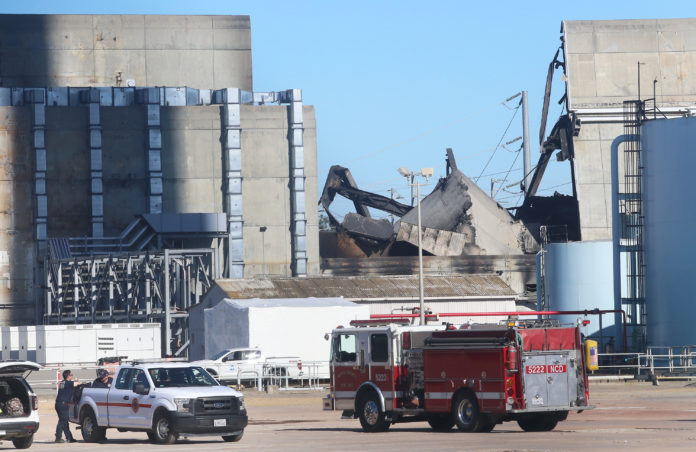
The Monterey County Board of Supervisors on Tuesday unanimously declared a state of emergency after the Jan. 16 fire at the Vistra battery storage facility in Moss Landing, a move that allows county officials to better respond to the disaster, and to request state and federal funding.
The supervisors also agreed to request that both Vistra and the adjacent PG&E battery plant not go back online until the cause of the fire has been determined, and the underlying safety concerns are addressed.
Supervisor Glenn Church, who made that motion, added that both companies should comply with Senate Bill 38, a state law that requires battery storage facilities to have detailed emergency action plans.
The requests carry no legal weight, since the facilities are regulated and approved by the state. Both can therefore return to business when they choose to do so.
Still, the vote sends a clear message from the supervisors—and from a furious and wary public who spoke for more than an hour about their concerns—that the incident was unacceptable.
Ed Mitchell said he is concerned about the particulate matter that settled on the ground after the fire, and how it might affect things such as water and crops.
“We don’t know what falls on the ground,” he said. “Will it be a threat to me or not?
He also asked who will be responsible for the cleanup.
“This is a technology that when it goes wrong, it’s not thrilling, it’s terrifying,” he said.
Similarly, Mary Larkin, who lives in Moss Landing, wondered who would pay to have drinking water sources tested for contaminants.
“I don’t think it should be the burden of the private residents to get this testing paid for,” she said.
Rebecca Little, of Prunedale, said her 5-year-old granddaughter developed a rash after the fire broke out. While doctors did not connect it to the fire, the event still left her shaken, particularly given the facility’s history.
“This is the fourth time that this is happening and we’re still here,” she said. “This is an awful thing that has happened.”
More than 200 people crammed into the Prunedale Grange Monday night to voice concerns flaring up around the fire.
Kiersten Nicholls-Marshall, who was in the crowd, said she could smell and taste “something like pool chemicals gone wrong” from her Echo Valley Road home in Prunedale Thursday and Friday.
Nicholls-Marshall said she also experienced a rash and blistering.
“My eyes were also burning,” she said. “Even today (Tuesday) I am tasting metal in my mouth.”
Santa Cruz County Supervisor Board Chair Felipe Hernandez said that he has asked both Vistra and Monterey County officials to give an update at the Jan. 28 meeting.
“So that in the future we can see what went wrong there, so we can have better policy here,” he said. “It’s about making local improvements.
Hernandez also said he wants to learn what happened in Monterey County, and what the impact is to the environment.
“We want to make sure that all residents are properly informed and engaged in this discussion,” he said.
The fire erupted at 3pm, with initial air monitoring beginning about an hour later. At 5:35pm, flames could be seen on the roof, and within hours residents in both Monterey and Santa Cruz counties were reporting seeing flames from miles away. The Monterey County Sheriff issued an evacuation order at 6:32pm.
Officials in Santa Cruz and Monterey counties warned residents to stay indoors, with their windows closed and air systems off.
The North Monterey County Unified School District closed its schools the next day and kept its 4,400 students home.
But despite the hours-long fire and the giant plume of black smoke that loomed over the facility, state and local officials said they did not detect dangerous levels of hazardous gases.
According to a report by Arkansas-based CTEH—a company that provides environmental consulting services after disasters—there were no hazardous levels of hydrogen fluoride, hydrogen chloride, carbon monoxide or hydrogen cyanide detected after the fire.
Experts from Monterey Bay Air Resources District and the Monterey County office of Environmental Health concurred.
At the meeting, Supervisor Church said he would seek to fight Vistra’s effort to restart operations.
“We need to stop it, pause it, slow it down,” he said. “Every single day that we can slow things down is a step in progress. This is a mess. They’re going to try to run us over, and they may run us over and we face some real challenges. … I’m not stepping aside; they’re going to run me over and they’re going to run us all over in one thought, but we’ve got to fight it.”
On Wednesday, Assemblymember Dawn Addis called for an independent investigation into the fire.
In a letter co-signed by Assemblywoman Gail Pellerin and Senator John Laird, Addis demanded that the California Public Utilities Commission investigate the incident, and that the plant remain shut down “until safety is guaranteed.”
“California must never have a disaster like this again,” Addis stated in a press release. “Vistra and its vendors should cooperate with any and all state investigations by sharing their data and allowing access to the site.”
Addis said that the plant is a “pivotal piece of our state’s energy future,” as the state looks to shift to renewable energy sources.
“However this disastrous fire has undermined the public’s trust in utility scale lithium-ion battery energy storage systems,” she said. “If we are to ensure California moves its climate and energy goals forward, we must demonstrate a steadfast commitment to safety, environmental stewardship, transparency, accountability, and emergency prevention.”
Church said that he understands that alternative energy sources such as battery storage facilities are essential for the future.
Still, that cannot come at the expense of public safety, he added.
“That’s gotta be the priority at this point,” he said. “Unfortunately it has become really clear for us here, and at other sites where there have been accidents, this technology is ahead of governments’ ability to regulate it, and industry’s ability to control it.”
Javier Gonzalez‑Rocha, an assistant professor of applied mathematics at UC Santa Cruz, said he studies the way pollution disperses in the environment, and uses drones to gather 3-D data
While he has not looked specifically at the Moss Landing fire, he said that the county’s air monitoring system is lacking, especially in South County.
“The thing that has baffled me is how few sensors there are in the Pajaro Valley, with the amount of agriculture we have going on,” he said.
Such monitoring would not have stopped the incident, Gonzalez‑Rocha said. But it would have provided more timely information about the chemicals that were released to help keep residents better informed.
“At least there wouldn’t have been the question of ‘are we exposed or are we not exposed,’” he said. “Because I feel like that was a big question mark.”













Supervisors should also ask why another 200 million battery plant has been approved for in Pajaro Valley. Who approved it? I read about it in the Santa Cruz Sentinel while the Reg Pajaronian has never informed readers about it. Get with it RP.
PAwatsonville…
You know who approved it? Liberals! And the liberal government in the area that dicatates us. Dont blame them, they been brain washed that batteries save the planet and its much cleaner, even though mining for Lithium pollutes chingos…
RP is selling fake news. They will never report anything that really matters.
Yea liberals love approving environmental friendly stuff like…..”chemical and battery plants.”
As we all know, batteries are only used to replace gasoline cars and not for any other purposes at all in life.
Great analysis genius
This is not political!